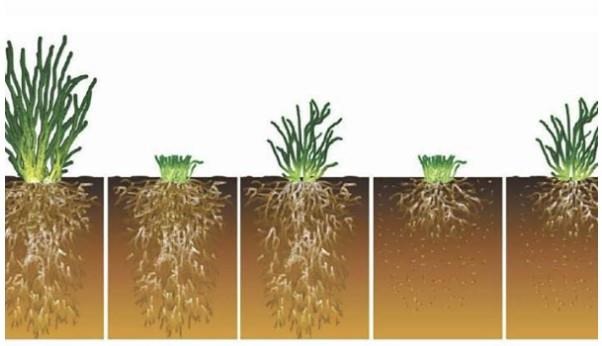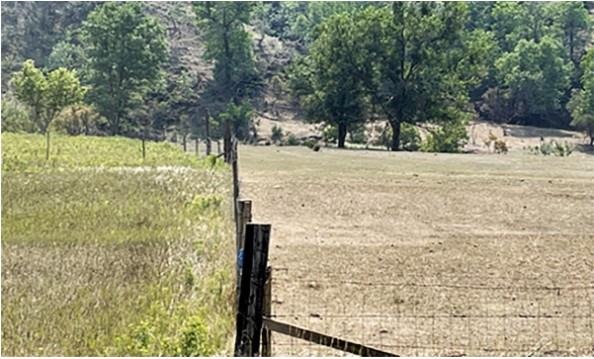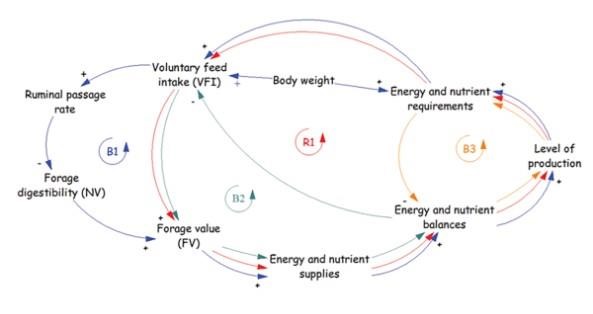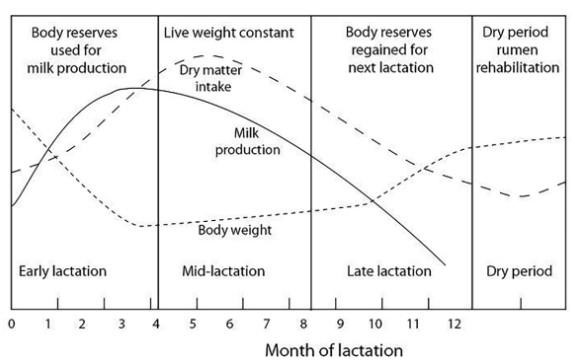By Krista Ehlert
Overgrazing can cause various detrimental effects on rangeland ecosystems. Most of the effects are seen in the short term, but some are unseen and can be lasting. Overgrazing upsets rangeland systems by causing problems with soil, forage, water and livestock interactions.
Overgrazing Overview
The definition of overgrazing is “excessive and continuous grazing, which causes damage to grass or rangelands.” The key word of that statement being “continuous,” as overgrazing is determined by the amount of time that livestock are allowed to graze, not by the actual amount of forage that they utilize. If livestock are allowed to graze a pasture, plant regrowth occurs, and then the same plants are regrazed before they receive adequate recovery – this is overgrazing (Figure 1). Overgrazing is regrazing plants before they have been allowed adequate recovery from the previous grazing event. The correct timing of the second grazing event, to prevent overgrazing, will depend on the type and amount of forage that is found in a pasture, along with the type of growth stage that the forage is ending in preposition. For example, if livestock are in a pasture that is invaded with cool-season grass species, heavy grazing utilization (up to 80%) is recommended if the goal is to break these dominant species up. Then, if adequate recovery time is allowed before grazing again, this would not be considered overgrazing.

Figure 1. Overgrazing is regrazing a plant before it is allowed to fully recover from the previous grazing event, as shown in this image.
When the same palatable grasses that livestock select for are continuously grazed, they will eventually be replaced with unpalatable, or invasive plant species. Plant species diversity will be reduced to a few, undesirable plants that better withstand heavy or repeated grazing pressure, such as:
- Noxious weeds: Canada thistle, leafy spurge, absinth wormword.
- Invasive weeds: Kochia, pigweed, lambsquarter.
- Invasive cool-season grasses: Kentucky bluegrass, crested wheatgrass, smooth brome.
- Indicator plants (plants that appear due to a disruption in the natural ecosystem, such as overgrazing): Abundance of forbs and woody plants, such as cudweed sagewort, silverleaf scurfpea, curlycup gumweed, buckbrush, or grasses that respond to disturbance, such as red threeawn, foxtail barley and buffalograss.
Overgrazed pastures tend to favor these plant species, because they can tolerate heavy grazing due to low growth points on the plant stem (below where grazing occurs), or the plants have characteristics, such as awns (plant parts that cause chewing to be difficult or can poke cattle while attempting to graze) or an unpalatable smell or taste to ensure livestock will not graze them. The plants noted above are characterized by short, shallow root systems, low grazing value and low production. After overgrazing a pasture, significantly lower forage production will be noticed in the following years. Palatable, desirable plants often need a longer recovery period after being overgrazed to “catch up” to normal production.

Figure 2.On the right side of the fence, a severely overgrazed and degraded pasture with little to no standing forage. On the left side of the fence, leafy spurge, a noxious weed, has moved in from the neighboring disturbance
If bare soil is present due to continuous overgrazing, weedy plant species will often be the first to grow and cover the area – they are ecologically adept at taking advantage of disturbances, such as overgrazing. Weeds act as a band-aid on bare ground, trying to cover and protect the soil from further disturbance or erosion, and they take advantage of areas with low competition for water and sunlight. At this juncture, if good grazing management is practiced, plant succession will begin. The weeds will act as a doormat for more-aggressive plant species, such as invasive cool-season grasses to establish.
The invasive cool-season grasses can then be managed or manipulated to allow for native range plants to re-establish in the ecosystem. Re-establishing native plants requires an extended period of time (years) for the plant succession process to occur, even under the best management and ideal growing conditions. If pastures have continually been overgrazed, degradation can be too intense for the original plant species composition to return to what it once was without direct seeding/establishment of native plants species.

Figure 3. Feedback loops of variables that alter voluntary feed intake. Self-reinforcing (R) and self-correcting (B) loops are shown within the semicircle arrows.
LIVESTOCK
Livestock production is generally the first variable that is noticed to take a hit in terms of pounds on calves, body condition scores and breeding rates. If pastures are overgrazed and/or available plants are of poor quality or palatability, voluntary feed intake (VFI) will be reduced (Figure 3). Within grazing systems, reinforcing loops (R) can lead to increased or decreased behavior (R1 = continued VFI), while balancing loops cause behavior to go toward an equilibrium (B3 = limited energy balances based on cattle level of production). Understanding grazing feedback relationships is important, because management actions in one area lead to unintended consequences in others.
For example, a reduction in forage quality will cascade into digestibility, forage value and eventually reduce energy and nutrient balances (Figure 3). The energy and nutrient balances are relative to cattle phases (levels of production), such as yearly steer growth rates, time for heifers to reach puberty and days in milk. Ultimately, failure to keep energy balances positive will reduce body weight, causing fat reserves to be used to meet levels of production, after which muscle tissue will begin to be mobilized, an extremely inefficient process. Use of fat and protein reserves will be visibly evident in body condition scores (BCS). It is helpful to keep records of weight to use an objective measurement in combination with body condition scoring, a subjective measurement (it differs from person to person). New technology, such as real-time precision weight scales, help provide more timely cattle performance data on which to make management decisions.

Figure 4. Dry matter intake, milk yield and live weight changes in a cow during her lactation cycle.
Maintaining a positive energy and nutrient balance is important for successful cattle breeding. If grazing heifers or cows, consider matching animal requirements to forage quality and quantity, because forage will change considerably throughout the grazing season, as do the nutrient requirements of cattle at different levels of production (Figure 4). Throughout different production phases, crude protein (CP) and energy (total digestible nutrients; TDN) requirements change, especially during pregnancy and lactation phases (Tables 1 and 2).
Primiparous heifers, or heifers breeding back as two-year-olds, need special attention in terms of nutrient requirements, because nutrient demands include calving for the first time and currently nursing a newborn calf, while continuing to grow into a mature cow. In terms of the big picture, if you are overgrazing forage, you are setting your cattle herd up to potentially have reduced breeding rates because of poor forage quantity and quality. An unintended consequence is that open cattle are still consuming valuable forage resources that could be utilized by pregnant cows or heifers, wasting animal unit months (AUMs) on pasture.
Table 1. Nutrient requirements for beef cows at different phases of pregnancy (NRC, 2000; OSU, 2004).
| Stage | Crude Protein,
CP (% DM) | Total digestible nutrients,
TDN (% DM) |
|---|
| Early lactation ab | 8.5-10.5 | 55-59 |
| Mid-lactation to early pregnancy ac | 8.5-10.5 | 55-59 |
| Late lactation to mid-gestation d | 7.1 | 52 |
| Late gestation d | 7.9 | 54 |
a Range for 900-1500-pound cows.
b Peak milk production; requirements are on the upper end of the range.
c Moderate-high milk production.
d 900-1500-pound cows.
Table 2. Nutrient requirements beef cattle at different levels of production (NRC, 2000; OSU, 2004).
| Class of Cattle | Crude Protein,
CP (%) | Total digestible nutrients,
TDN (%) |
|---|
| Growing animals | 12-13 | 60-65 |
| Lactation mature cows | 10 | 55-60 |
| Dry mature cows | 7-8 | 50-55 |
Summary
The amount of degradation that can be done to the rangeland ecosystem in one year of overgrazing is immense. From lowering soil health, to harming the native plant species and decreasing overall forage production, to lowered weaning weights and breeding rates, the negative impacts will be seen and felt for years to come. Thus, it is recommended that producers develop a strong grazing plan and implement good recording keeping and monitoring to prevent overgrazing from occurring in the first place.
Source : sdstate.edu